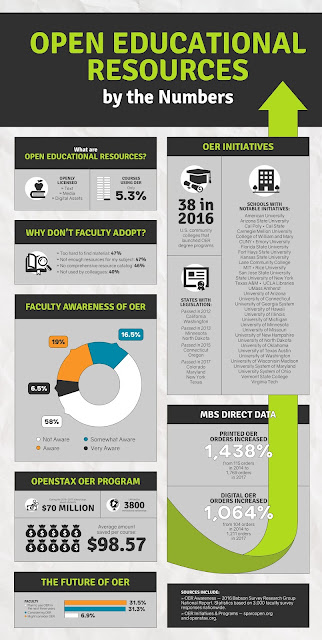OER...umm Open Educational Resources!
If you don't know by now, I a huge fan of infographics. They give you the opportunity to take a whole lot of information and put it in one place that is easy to read. Sort of like a poster session. I like poster sessions. Many times this information can tell a story that graphically that is more profound than the verbal or print telling.
OER is also something that has had my interest for the past few years. Working in higher ed, I have seen the struggles of students and if there is something that we can do about it, then we should. The problem with OER is that it takes "out of the box" thinkers and some educators don't want to leave the confines of their box. It is safe and warm and allows me to collect a paycheck.
But, I understand their dilemma and their need for support. I was a kindergarten teacher. If anyone remembers their kindergarten teacher or knows a kindergarten teacher, you know that they are the MacGyvers of the education world. We create at will. The bottom on little Johnny's shoe fall off and you can't get in touch with the parents? No problem, fix it with duct tape, glue it or go to the art teacher's room to see what she has. All children must have their free play time! But there are other's that are not as adventurous and that is okay. We need to move these naysayers by providing them with assistance in locating, creating and implementing OER.
Another problem area is often...time. Many professors may have workloads that don't allow them the time to do that type of planning. Compensation for that can be a HUGE plus. If a professor teaches multiple courses, then that can add to the strain. I am not saying this is right, I am just saying that it is true.
Content can also be a factor. If the content is not up to the standard of the course, then modifications need to be made and that of course leads back to ...time.
How can we fix this? I am not always sure, but an approach that is faculty friendly can definitely help.
- Introduce the concept to a group or department. Sometimes people have a fear of being isolated so have a team and give them the sense of why they are doing it. Create a community feel to the project.
- Have items available for them to view. If they have to find it, that turns many people off. (Remember that time thing I keep mentioning)
- Variety. Merlot is good but for a chemistry professor, you may want to try OpenStax (and they will customize)
- Keep the invitation open. Don't be forceful. If someone isn't interested don't push, find out why. There may be small things that you can do to help them make the transition slowly.
- Keep an eye on dates that materials may have been created, updated and number of times used.
This is simply a band-aid, but over time things heal. Maybe we can be a part of a textbook revolution.


Very interesting insights Pamela. I, especially, loved your tips toward the end. I think they make a lot of sense. I see many great benefits of OERs: expanded access, scalability, quicker circulation, collaboration, and many more. On the flip side, you're quite right about resource-allocation issues along with quality concerns. I love infographics too. Do you have any specific tools that you use to create them? Thanks!
ReplyDeleteI pulled this one from Pinterest, however Canva is my go-to for being creative and it is free for the most part. You can add upgrades for about a dollar.
Deletehttps://www.canva.com/